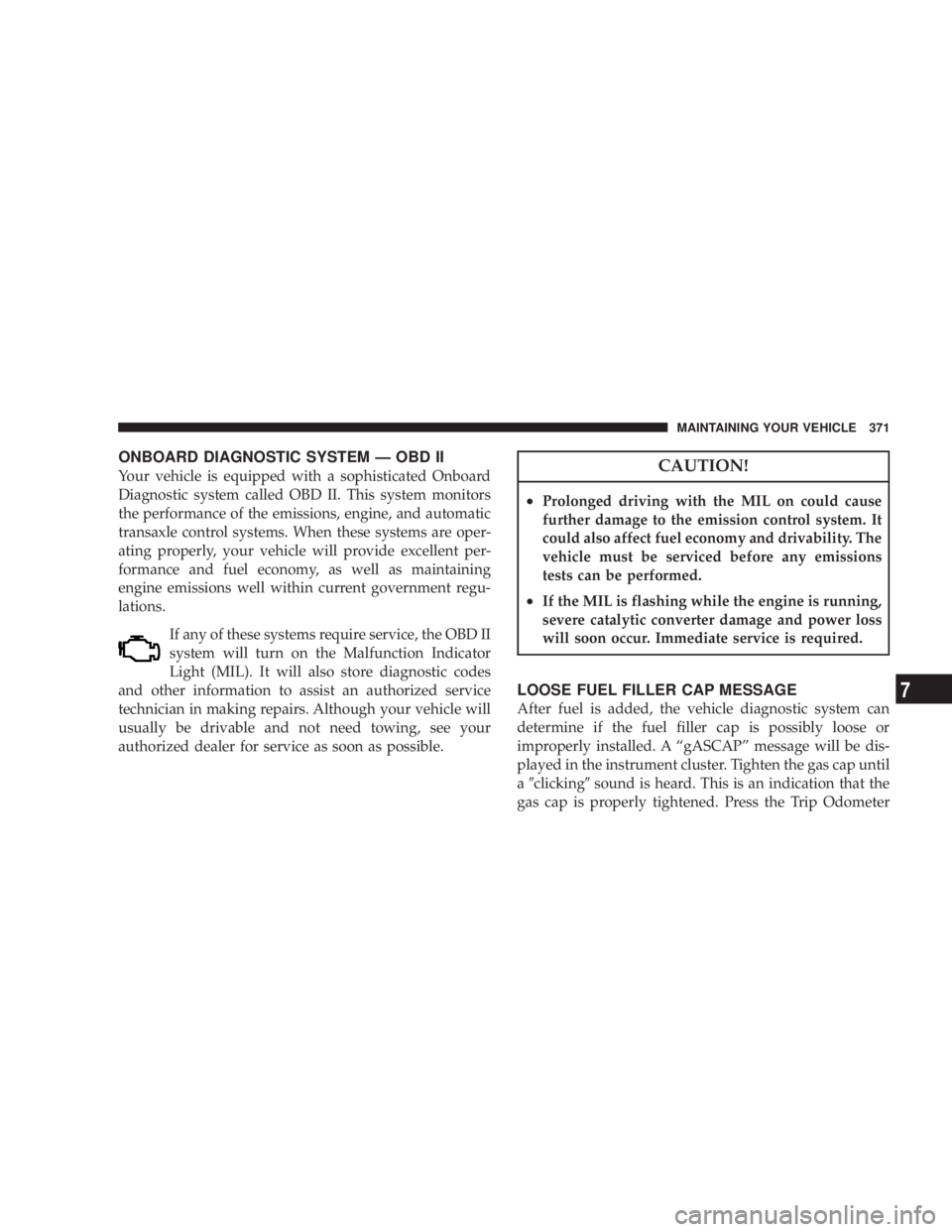Page 367 of 467
MAINTAINING YOUR VEHICLECONTENTS m 2.4L Engine Compartment ................368
m 2.7L Engine Compartment ................369
m 3.5L Engine Compartment ................370
m Onboard Diagnostic System Ð OBD II ........371
N Loose Fuel Filler Cap Message ............371
m Emissions Inspection And Maintenance
Programs .............................372
m Replacement Parts ......................373
m Authorized Dealer Service ................374 m Maintenance Procedures ..................374
N Engine Oil ..........................374
N Engine Oil Filter ......................378
N Drive Belt ...........................378
N Spark Plugs .........................379
N Engine Air Cleaner Filter ................379
N Catalytic Converter ....................379
N Maintenance-Free Battery ................381
N Air Conditioner Maintenance .............382
7
Page 369 of 467
N Center High-Mounted Stop Light ..........418
m Fluids And Capacities ...................420 m Fluids, Lubricants, And Genuine Parts ........422
N Engine .............................422 MAINTAINING YOUR VEHICLE 367
7
Page 370 of 467
2.4L ENGINE COMPARTMENT 368 MAINTAINING YOUR VEHICLE
Page 371 of 467
2.7L ENGINE COMPARTMENT MAINTAINING YOUR VEHICLE 369
7
Page 372 of 467
3.5L ENGINE COMPARTMENT
3.5L Engine370 MAINTAINING YOUR VEHICLE
Page 373 of 467

ONBOARD DIAGNOSTIC SYSTEM Ð OBD II
Your vehicle is equipped with a sophisticated Onboard
Diagnostic system called OBD II. This system monitors
the performance of the emissions, engine, and automatic
transaxle control systems. When these systems are oper-
ating properly, your vehicle will provide excellent per-
formance and fuel economy, as well as maintaining
engine emissions well within current government regu-
lations.
If any of these systems require service, the OBD II
system will turn on the Malfunction Indicator
Light (MIL). It will also store diagnostic codes
and other information to assist an authorized service
technician in making repairs. Although your vehicle will
usually be drivable and not need towing, see your
authorized dealer for service as soon as possible. CAUTION!² Prolonged driving with the MIL on could cause
further damage to the emission control system. It
could also affect fuel economy and drivability. The
vehicle must be serviced before any emissions
tests can be performed.
² If the MIL is flashing while the engine is running,
severe catalytic converter damage and power loss
will soon occur. Immediate service is required.
LOOSE FUEL FILLER CAP MESSAGE
After fuel is added, the vehicle diagnostic system can
determine if the fuel filler cap is possibly loose or
improperly installed. A ªgASCAPº message will be dis-
played in the instrument cluster. Tighten the gas cap until
a 9 clicking 9 sound is heard. This is an indication that the
gas cap is properly tightened. Press the Trip Odometer MAINTAINING YOUR VEHICLE 371
7
Page 374 of 467

RESET button to turn off the message. If the problem
persists, the message will appear the next time the
vehicle is started. This might indicate a damaged cap. If
the problem is detected twice in a row, the system will
turn on the MIL. Resolving the problem will turn the MIL
light off.
EMISSIONS INSPECTION AND MAINTENANCE
PROGRAMS
In some localities, it may be a legal requirement to pass
an inspection of this vehicle's emissions control system.
Failure to pass could prevent vehicle registration.
For states that require an Inspection and Mainte-
nance (I/M), this check verifies the Malfunction
Indicator Light (MIL) is functioning and is not on
when the engine is running, and that the OBD II system
is ready for testing. Normally, the OBD II system will be ready. The OBD II
system may not be ready if the vehicle was recently
serviced, recently had a dead battery, or a battery replace-
ment. If the OBD II system should be determined not
ready for the I/M test, the vehicle may fail the test.
This vehicle has a simple ignition key-actuated test,
which you can use prior to going to the test station. To
check if this vehicle's OBD II system is ready, you must
do the following:
1. Insert the ignition key into the ignition switch.
2. Turn the ignition to the ON position, but do not crank
or start the engine.
3. If you crank or start the engine, you will have to start
this test over.
4. As soon as you turn the ignition key to the ON
position, you will see the MIL symbol come on as part of
a normal bulb check.372 MAINTAINING YOUR VEHICLE
Page 375 of 467

5. Approximately 15 seconds later, one of two things will
happen:
a. The MIL will flash for about 10 seconds and then
return to being fully illuminated until you turn OFF
the ignition key or start the engine. This means that the
vehicle's OBD II system is not ready and you should
not proceed to the I/M station.
b. The MIL will not flash at all and will remain fully
illuminated until you turn OFF the ignition key or start
the engine. This means that the vehicle's OBD II
system is ready, and you can proceed to the I/M
station.
If the OBD II system is not ready, you should see an
authorized dealer or repair facility. If this vehicle was
recently serviced or had a battery failure or replacement,
you may need to do nothing more than drive the vehicle as you normally would in order for the OBD II system to
update. A recheck with the above test routine may then
indicate that the system is now ready.
Regardless of whether the vehicle's OBD II system is
ready or not ready, if the MIL is illuminated during
normal vehicle operation, you should have the vehicle
serviced before going to the I/M station. The I/M station
can fail the vehicle because the MIL is on with the engine
running.
REPLACEMENT PARTS
Use of genuine Mopar t parts for normal/scheduled
maintenance and repairs is highly recommended to en-
sure the designed performance. Damage or failures
caused by the use of non-Mopar t parts for maintenance
and repairs will not be covered by the manufacturer's
warranty. MAINTAINING YOUR VEHICLE 373
7